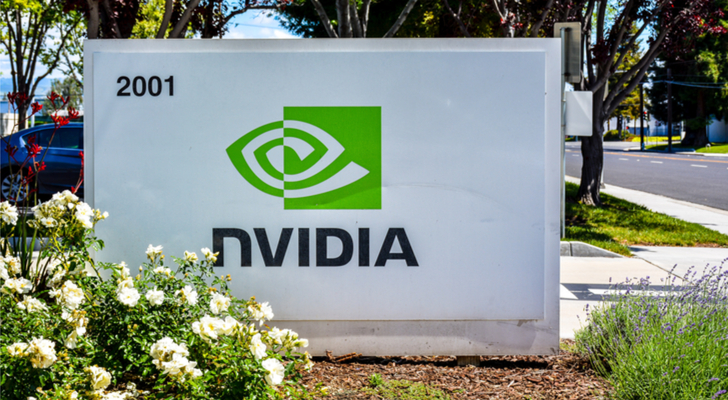Last week, chipmaker — and graphics processing specialist — Nvidia Corporation (NASDAQ:NVDA) unveiled some encouraging but perhaps unusual news. That is, Chinese internet powerhouse Tencent Holdings Ltd (OTCMKTS:TCTZF) has selected Nvidia as the provider of its core hardware needed to make Tencent’s artificial intelligence ambitions a reality.

It was odd, simply because that’s not what Nvidia does. A more conventional computer processor and chipset name like Advanced Micro Devices, Inc. (NASDAQ:AMD) or Intel Corporation (NASDAQ:INTC) would make more sense serving as the backbone for a new AI system.
Thing is, this isn’t the first time owners of NVDA stock have heard of the company’s hardware being selected as the centerpiece of an artificial intelligence system. Just two weeks ago, Nvidia was tapped by Microsoft Corporation (NASDAQ:MSFT) to power the next generation of its AI offering.
What gives?
As it turns out, traditional computer processors like Intel’s Core and Pentium CPUs or AMD’s Ryzen aren’t necessarily best-suited for the ultra-high-speed processing needs the rise of AI has created. Investors — and not just NVDA stock holders — would be wise to note the nuance, as AI is expected to become a $16 billion market by 2022, and grow to $36 billion by 2025.
GPU Technology vs. CPU Technology
Historically, while the hardware and firmware supporting a computer’s (or laptop’s) display screen was a key part of its performance, a device’s heart and soul was its processor, or CPU. It operates… well, everything at blazing fast speed, with more RAM (memory) helping out.
The graphics processing unit, or GPU, wasn’t a dealmaker or a dealbreaker.
As computers have become faster and more powerful, though, and performance expectations have swelled, GPUs have become very, very impressive, in many cases fully taking on the display-management role that was otherwise taken on by the CPU. Indeed, a GPU is some4thing of a mini-computer in itself…
… and they’re very, very fast. That makes them perfect for high-speed artificial intelligence applications, where the quantity of computations is more important than the depth or complexity of those computations.
An entry posted at the Nvidia corporate blog in the middle of last year not only served as something of an omen to the tech world, but to savvy owners of Nvidia stock as well. It explains:
“Computer programs contain commands that are largely executed sequentially. Deep learning is a fundamentally new software model where billions of software-neurons and trillions of connections are trained, in parallel. Running DNN algorithms and learning from examples, the computer is essentially writing its own software. This radically different software model needs a new computer platform to run efficiently. dlboost-3-webAccelerated computing is an ideal approach and the GPU is the ideal processor. As Nature recently noted, early progress in deep learning was “made possible by the advent of fast graphics processing units (GPUs) that were convenient to program and allowed researchers to train networks 10 or 20 times faster.”
That’s what Microsoft knew a couple of weeks ago when it asked Nvidia to provide the computing power for its HGX-1 hyperscale GPU accelerator, specifically for cloud-based artificial intelligence applications.
Nvidia CEO Jen-Hsun Huang added of the new Microsoft/Nvidia venture:
“AI is a new computing model that requires a new architecture. The HGX-1 hyperscale GPU accelerator will do for AI cloud computing what the ATX standard did to make PCs pervasive today. It will enable cloud-service providers to easily adopt NVIDIA GPUs to meet surging demand for AI computing.”
ATX, short for Advanced Technology-eXtended, is motherboard configuration that paved the way for the proliferation of PCs thereafter by standardizing how they would be assembled and what sort of hardware could be connected to them.
The biggest leap forward since ATX was unveiled would be a game-changer indeed. With Tencent and Nvidia now taking another step down that road, Nvidia is emerging as a key player in a market few expected it to be in.
Nvidia’s deep-learning technology is also part of its autonomous driving platform, though it remains to be seen exactly what its future looks like on that front.
Bottom Line for Nvidia Stock
For all intents and purposes, Nvidia stock is still mostly an investment in tech company that makes computer displays work. That’s not apt to change anytime in the immediate future. Given time though, artificial intelligence is positioned to be a big piece of the company’s revenue pie. Current and would-be shareholders need to add the subject of AI to the company’s future report cards.
As of this writing, James Brumley did not hold a position in any of the aforementioned securities.
